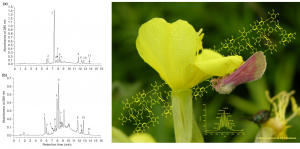There is no such thing as chemical ecology without the chemistry counterpart and for plants chemistry can really make a difference, if you can appreciate hard work and detailed results
Chemists can help ecologists – and vice versa

Figure 1. Our ongoing journey with chemical ecology began with the analysis of mountain birch chemistry to help the legendary Haukioja group to better understand autumnal moth – mountain birch interactions in Lapland. It is perhaps not an overstatement to say that this specific interaction is one of the most studied ones in the field of plant-herbivore interactions.
Studies of the chemical aspects of birch-insect interactions in early 1990's began our lab's long-lasting scientific path in the field of chemical ecology. At first we focused on understanding the chemistry of mountain birch leaves and used that to help the local ecologists to better understand birch-insect interactions (Fig. 1). Altogether, chemical ecology is a field where collaboration with high-quality ecologists is a necessity for chemists to achieve results of high importance. The same goes naturally to ecologists. We are not sure if this is always understood.
Collaboration and passion for science – keys to possible success
We have been very lucky by attracting many of the top ecologists to work with us. To start this journey together with the group of professor emeritus Erkki Haukioja in 1990’s was clearly crucial. Without these first steps, we certainly would not be here where we are now. Until his retirement, Erkki had huge scientific ambitions and a wonderful group. Both are simply crucial even today and if one of these components is missing, it gets way more difficult to make science. It is actually difficult to understand why to choose an academic career, if one has no true passion for science. Those days are gone when university was seen as the safe haven for people who wanted to do nothing or only very little.
Co-evolution of plants and herbivores – challenges to phytochemists

Figure 2. Agrawal et al. (2012) found that insect herbivores are able to drive evolutionary steps in a plant population and that this results in Oenothera biennis genotypes that produce larger rather than smaller ellagitannin oligomers to increase in frequency. Some genotypes producing small oligomers even got extinct. From the genotypes that overexpressed the production of large ellagitannins, we were able to find the largest ever ellagitannins produced in the plant kingdom. Sub-stories of this success story can be found also in Johnson et al. (2009), Karonen et al. (2010), Parker et al. (2010), Salminen et al. (2011), Parker et al. (2012), McArt et al. (2013), Johnson et al. (2014), Anstett et al. (2015), and Lemoine et al. (2017).
For most parts our studies of chemical ecology have related to plant-herbivore interactions, or more specifically plant-insect interactions. This field is quite challenging, since the ongoing evolution of both plants and insects causes a continuation of changes in the ability of plants to effectively defend themselves against herbivores and in the ability of herbivores to tolerate plant defensive chemicals. To follow this battle that causes evolutionary shifts in the production of plant metabolites is actually very fascinating for a phytochemist, since it opens up possibilities to finding fully new types of compounds in plants (Fig. 2).
Chemical ecology of plants – multiple points to consider
If one wants to link plant chemistry to one or more ecological phenomena, then it makes sense to have as correct knowledge of the plant chemistry as possible. This is not a trivial task at all, although sometimes it is taken that way. To understand the effects of plant chemistry on any of the plant-mediated interactions in a bigger picture, we must be able to dig deep on all these four sub-categories: (1) Chemical Analysis of Plants, (2) Plant Phylogeny & Chemotaxonomy, (3) Ontogenic and Within-Species Variation, and (4) Seasonal Variation of Defense Compounds.
Additional information is available from our pages for the Quantitative Analysis of Plants (updated soon), Qualitative Analysis of Polyphenols, and Tannin and Polyphenol Chemistry.
“Chemical Ecology of Plants – sounds close enough to Phytochemistry to me.”
